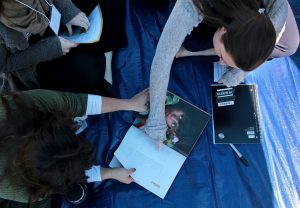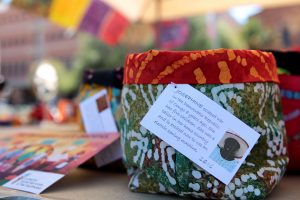- Slug: BC-CNS-Refugees Shoes. 940 words.
- 3 photos and captions below.
- Video here.
By NICOLE LUDDEN
Cronkite News
TUCSON – When war broke out in Bosnia Herzegovina, Nejra Sumic was forced to do what more than 3 million people have done since 1980: flee to the United States.
During the tumultuous 1990s in Bosnia Herzegovina, Sumic says, her family was persecuted for practicing their Muslim religion and forced to uproot their lives.
“We went through that journey of having to travel through multiple countries. We had to live in a camp where the conditions were very unsanitary,” she said. “You didn’t have any privacy. You had limited resources.”
These conditions were mimicked in the second annual Walk a Mile in a Refugee’s Shoes event at the University of Arizona last week, which Sumic appropriately helped coordinate.
On a large grass lawn on campus, participants got a taste of the often trying experiences refugees face when resettling in the United States.
Sumic, as the state refugee organizer for We Are All America, a national organization that focuses on inclusivity for refugees and asylum seekers, hopes the event brings attention to the relatively low number of refugees currently resettling in the U.S., even though the global refugee population has increased by 50 percent within the past five years.
“On an average, three or four years ago, Arizona used to get a little over 4,000 refugees,” Sumic said. “Now, we’re lucky if we get a thousand. So, we’ve seen that number dramatically drop.”
Every year, the president decides the number of refugees allowed to resettle in the U.S. In fiscal 2019, President Donald Trump set the cap at 30,000 refugees, a historic low.
According to Sumic, this low admission rate is an administrational issue.
“It’s directly related to the current administration’s immigration policy,” Sumic said. “The U.S. is one of the countries that takes the lowest number of refugees. It’s really, really unfortunate and concerning that a program that has had bipartisan support is now being placed to be perceived in such a negative, very scary way.”
The Walk a Mile simulation at UA aimed to bring awareness to this issue, as well as to the hardships refugees face in the resettlement process.
The event – a collaboration among the University of Arizona human rights department, the International Rescue Committee of Tucson and We Are All America – lead participants through seven tented stations, beginning at a mock border station.
There, Mary Butler and her five sons quickly learned the reality of being a refugee.
“They separated our family, and I had a reaction. I was starting to feel kind of anxious and like if that had really happened to me, I wouldn’t have gone quietly,” Butler said. “I don’t know why they think they can do that to people. That really made me upset.”
After receiving a refugee identity at the border station tent, and possibly being split from those they came with, participants were sent to different stations simulating the trials of being a refugee.
At the water station, participants were given jugs of water to lug around the perimeter of the event to represent a fraction of the long distances refugees must walk hauling water from wells at refugee camps. After making a lap with the water, participants were instructed to choose a small water bottle marked with a letter on its cap. If an “A” water bottle was chosen, that participant contracted typhoid.
“A lot of times the water you’re receiving is not even clean. This is a reality for a lot of refugees,” said Jenna Rosenfeld, an intern with the International Rescue Committee. “After they go and spend their entire day receiving water and making a whole plight to go receive water, the water they receive is now useless because it is contaminated.”
One station was a small, crowded tent similar to those at actual refugee camps.
Another station instructed participants to draw a piece of paper out of a bag with an illness written on it. The participant would then be told the station didn’t have the resources to treat it.
On the other side of the lawn, the food station housed a table holding sugary liters of soda and bags of rice; examples of the cheap, high-calorie food options refugees have.
One refugee family from Congo bore witness to the similarities of the simulation to real refugee camps.
“This is a good thing, because we are remembering how far we came from and how we are here,” said Jean Paul, who fled Congo with his family in 1996. “In refugee camps, it is the way we were.”
Paul also confirmed the specific aspects of refugee life the simulation brought to light.
“It’s a long journey for the refugee and people are in camps suffering. All of them, they seek to come here because they don’t have food,” Paul said. “They want to leave. They don’t get enough space to live. They don’t have work.”
After filtering through the stations with her family, Mary Butler has a new perspective on the lives of refugees.
“I’m learning things that are really disturbing, that have made me feel emotional, have made me want to do things,” Butler said. “I didn’t know that this was such a world-wide issue for individuals and families.”
Sumic, one of the organizers of the event, hopes the simulation stirs empathy in all those who attended.
“I really hope that people have more compassion toward refugees, that they use this as an educational and learning opportunity,” she said. “We’re not just putting this event together to signify that refugees only experience hardships and pain, but they’re also very resilient.”
Have a story idea? Email us at cronkitenews@asu.edu.
For more stories from Cronkite News, visit cronkitenews.azpbs.org.
^_=


